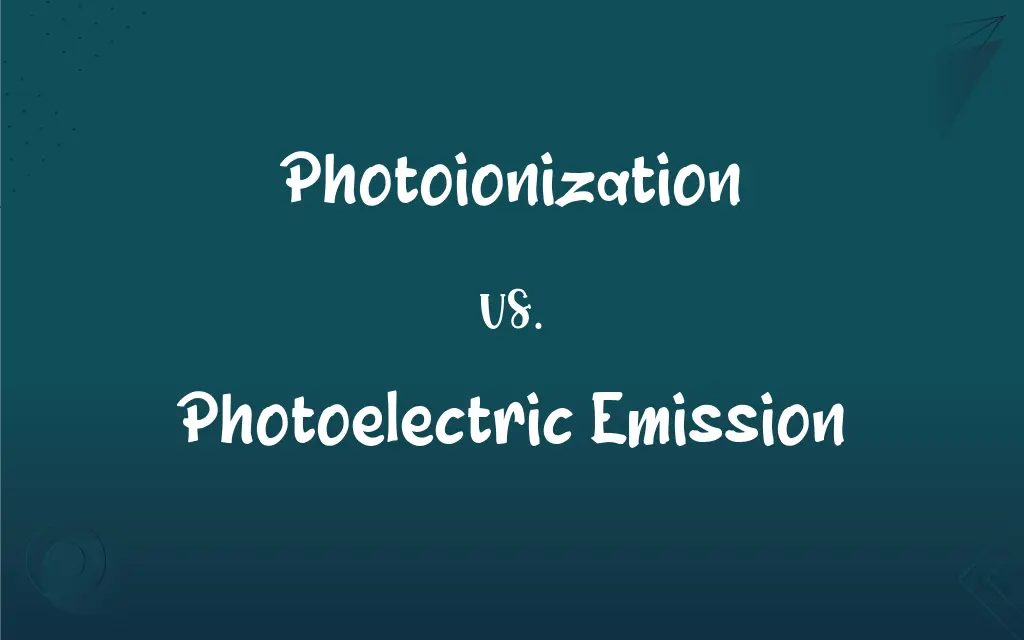Photoionization vs. Photoelectric Emission: What's the Difference?
Edited by Harlon Moss || By Janet White || Published on September 14, 2024
Photoionization is the process of removing an electron from an atom/molecule using light, while photoelectric emission involves ejecting electrons from a material's surface using light.

Key Differences
Photoionization occurs when photons (light particles) provide enough energy to ionize atoms or molecules by removing one or more electrons. This process is significant in fields like astrophysics and plasma physics. Photoelectric emission, on the other hand, describes how electrons are ejected from a material, typically a metal, when it absorbs light. This phenomenon is fundamental in understanding classical and quantum physics, and it led to the development of quantum mechanics.
Photoionization requires photons with sufficient energy to overcome the binding energy of electrons in atoms or molecules. The outcome is an ion with a positive charge. In contrast, photoelectric emission involves photons dislodging electrons from the surface of materials, with the energy of the emitted electrons being dependent on the light's frequency, illustrating the quantum nature of light.
Photoionization is widely used in spectroscopy for analyzing the composition of materials and in astronomy to understand interstellar media. Photoelectric emission has practical applications in photodetectors and solar panels and was pivotal in the historical validation of quantum theory.
Photoionization plays a critical role in understanding atomic and molecular structures and dynamics. It is also crucial in studying the ionization balance in stars. Photoelectric emission, conversely, demonstrates the particle nature of light and is essential in the study of electron properties in materials.
Photoionization is often studied using advanced spectroscopy techniques, which allow scientists to observe and measure the ionization process. Photoelectric emission is typically observed in photoelectric cells or tubes, enabling precise measurements of electron ejection related to light properties.
ADVERTISEMENT
Comparison Chart
Process
Removal of electrons from atoms/molecules by light
Ejection of electrons from material's surface by light
Energy Requirement
Photon energy must exceed the ionization energy of the electron
Photon energy must overcome the work function of the material
Outcome
Creation of ions
Liberation of free electrons
Applications
Spectroscopy, astronomy
Photodetectors, solar panels
Theoretical Significance
Helps understand atomic/molecular structures, ionization in stars
Demonstrated quantum nature of light, studies on electron behavior
ADVERTISEMENT
Photoionization and Photoelectric Emission Definitions
Photoionization
Photoionization refers to the process of forming ions under the influence of electromagnetic radiation.
In astrophysics, photoionization is key to understanding the ionization states of nebulae.
Photoelectric Emission
Photoelectric emission refers to the phenomenon where light causes the ejection of electrons from solids.
Photoelectric emission from metallic surfaces is crucial in night vision technology.
Photoionization
Photoionization is the process where light causes the ionization of atoms or molecules.
The photoionization of hydrogen atoms in the interstellar medium contributes to the formation of H II regions.
Photoelectric Emission
Photoelectric emission is the light-triggered liberation of electrons from a material.
In photomultiplier tubes, photoelectric emission amplifies weak light signals.
Photoionization
Photoionization is a photon-induced phenomenon resulting in the creation of charged particles.
Photoionization detectors are used to measure volatile organic compounds in the air.
Photoelectric Emission
Photoelectric emission describes the process of electron discharge from surfaces due to photon absorption.
The photoelectric effect in photocells converts light into electrical signals.
Photoionization
Photoionization is the liberation of an electron from an atom or molecule due to photon impact.
The study of photoionization rates helps in modeling the Earth's upper atmosphere.
Photoelectric Emission
Photoelectric emission involves ejecting electrons from substances via photon interaction.
Photoelectric sensors use the emission of electrons to detect light changes.
Photoionization
Photoionization occurs when photon absorption leads to the ejection of an electron from an atom.
In photoionization mass spectrometry, photon absorption ionizes molecules for analysis.
Photoelectric Emission
Photoelectric emission is the release of electrons from a material's surface induced by light.
The photoelectric effect in metals is utilized in solar panels to generate electricity.
Photoionization
Alternative spelling of photoionisation
FAQs
What is photoionization?
It's the process where photons ionize atoms or molecules by removing electrons.
How does the energy of photons affect photoionization?
Photons need enough energy to exceed the electron's binding energy for photoionization.
What is photoelectric emission?
It refers to the ejection of electrons from a material's surface by light.
What role does photon frequency play in photoelectric emission?
Higher photon frequencies can increase the kinetic energy of emitted electrons.
How is photoelectric emission used in everyday technology?
In devices like solar panels and light sensors.
Are photoionization and photoelectric emission related to quantum mechanics?
Yes, both phenomena are explained by quantum theory.
What happens to the atom after photoionization?
It becomes positively charged (ion).
Can photoelectric emission be observed directly?
Yes, in photoelectric cells and similar devices.
What materials exhibit photoelectric emission?
Mostly metals, but also some semiconductors and insulators.
What happens to the electrons in photoelectric emission?
They are ejected and can be collected as an electric current.
Can photoionization occur in any type of atom?
It can, provided the photon energy is sufficient for that specific atom.
Is photoionization significant in astronomy?
Yes, particularly in studying stars and interstellar matter.
Does photoionization have practical applications?
Yes, in fields like spectroscopy and environmental monitoring.
Is photoionization always a one-electron process?
Not necessarily; multiple electrons can be ionized.
Can photoionization lead to chemical changes?
Yes, it can initiate chemical reactions in certain conditions.
Can photoionization be used to purify air?
Yes, in air purifiers using UV light to ionize and remove pollutants.
What was the historical significance of photoelectric emission?
It was crucial in the development of quantum mechanics.
Are there any health risks associated with photoelectric emission?
Generally no, but direct exposure to intense light sources should be avoided.
How do scientists study photoionization?
Using spectroscopy and other photon interaction measurements.
What factors affect the efficiency of photoelectric emission?
Material type, light intensity, and photon frequency.
About Author
Written by
Janet WhiteJanet White has been an esteemed writer and blogger for Difference Wiki. Holding a Master's degree in Science and Medical Journalism from the prestigious Boston University, she has consistently demonstrated her expertise and passion for her field. When she's not immersed in her work, Janet relishes her time exercising, delving into a good book, and cherishing moments with friends and family.
Edited by
Harlon MossHarlon is a seasoned quality moderator and accomplished content writer for Difference Wiki. An alumnus of the prestigious University of California, he earned his degree in Computer Science. Leveraging his academic background, Harlon brings a meticulous and informed perspective to his work, ensuring content accuracy and excellence.






































































